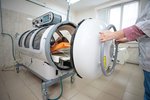At the Wound Recovery & Hyperbaric Medicine Center we treat patients suffering from wounds of all types from head to toe. But the majority of wounds we treat are located anywhere from the knee …
This item is available in full to subscribers.
We have recently launched a new and improved website. To continue reading, you will need to either log into your subscriber account, or purchase a new subscription.
If you are a current print subscriber, you can set up a free website account by clicking here.
Otherwise, click here to view your options for subscribing.
Please log in to continue |
|


At the Wound Recovery & Hyperbaric Medicine Center we treat patients suffering from wounds of all types from head to toe. But the majority of wounds we treat are located anywhere from the knee down to the toes. The lower legs are particularly vulnerable to wounding for a multitude of reasons, some of the most important being conditions affecting the arteries, veins and/or lymphatic system. Understanding this circulatory system is critical to keeping your legs healthy and knowing how to prevent complications later in life.
Peripheral arterial disease (PAD) is estimated to affect more than 200 million people worldwide. Common risk factors include smoking, diabetes, hypertension, high cholesterol, family history and advancing age. It is also worth noting that if you have known atherosclerotic disease, such as coronary artery disease of the heart, you likely suffer from some degree of PAD in the lower extremities. In some cases, patients can develop symptoms including pain in the legs that is brought on during periods of activity or exercise, and relieved with rest. This is known as claudication, and it is a sign of progressing PAD that should be assessed by a vascular specialist. If left untreated, PAD can continue to progress and lead to worsening pain, lower leg wounds and possibly even amputation. In the case of diabetic patients, they are not only at higher risk for PAD, but they also may not recognize the warning signs due to reduced sensation (neuropathy) in their lower legs and particularly feet. Proper foot wear is imperative to help prevent ulcerations from developing. Diabetic patients typically can qualify through their insurance for a set of custom fitted diabetic shoes every year. Patients should also perform daily foot checks at home and see a podiatrist regularly for foot and nail care.
Even if the arteries of your legs are healthy and effectively carrying blood down to your legs and toes, the blood still needs to travel back up through the veins. Unfortu-nately, venous problems are even more common, with vein abnormalities estimated to affect as much as 50% of individuals. Chronic venous insufficiency (CVI) is a disorder in which deoxygenated blood is not properly transporting through the veins, mostly com-monly those in the lower legs. Risk factors for CVI include smoking, obesity, leg trauma, deep vein thrombosis (DVT), family history, pregnancy, and advancing age. Individuals who work in jobs requiring prolonged periods of standing or sitting are also at increased risk. Signs of CVI can include varicose veins, dark pigmentation particularly at the shins, and lower leg swelling. As CVI progresses and swelling worsens, ulcers may develop most commonly at the ankle or calf regions. These types of wounds can be quite painful and debilitating, and individuals should seek care at a wound center. While this disease is not curable, it can be treated effectively with compression therapy. Initial treatment often includes compression wraps or compression stockings to improve transport of ve-nous blood up through the legs. Additionally, some individuals may benefit from a pneumatic compression pump device or venous ablation procedure to redirect blood away from diseased veins.
While arterial and venous diseases tend to get more attention, it’s important not to leave out the lymphatics. The lymphatic system includes a complex network of vessels throughout the body that have several functions including transport of fluid and proteins. Since lymphatic vessels work in conjunction with the venous system, those suffering from CVI are at risk to also develop lymphatic insufficiency, also known as lymphedema. Additional risk factors include obesity, trauma, infection, and various in-flammatory disorders. Cancer patients are also at particular risk to develop lymphedema secondary to treatments such as surgery, chemotherapy and radiation. The treatment of lymphedema is very similar to that of CVI including compression therapy, but some pa-tients may also benefit from manual lymph massage performed at a lymphedema clinic.
Even if you do not suffer from venous insufficiency or lymphedema, compression stockings are a great way to keep your legs healthy and prevent the development of wounds. The key to compression stockings is making sure they fit properly, knowing the compression level, and wearing them every day. For younger individuals without venous disease, a stocking with a compression level of 10-20 mmHg can be adequate. If you have some symptoms of venous insufficiency and varicose veins, I would recommend 20-30 mmHg compression stockings. For those suffering more severe venous disease and have a history of ulcerations, 30-40 mmHg compression stockings may be required. A caveat, however, is that if you also suffer from arterial disease in your legs, you may have to use a lower grade compression stocking. In cases of severe arterial disease, com-pression stockings may be contraindicated, as they can further restrict blood flow. In such cases, individuals should seek consultation with a vascular specialist before initiat-ing compression therapy.
I hope this overview has helped show that the old saying ‘get the blood flowing’ is actually great advice to maintain not just general health, but also healthy legs. Stay ac-tive, keep moving and get some good pairs of compression stockings if you’re a candi-date. And if you’re experiencing symptoms in your legs or suffering from wounds, go get evaluated by vascular specialist and/or wound center as soon as possible. We’re here to help!
Comments
No comments on this item Please log in to comment by clicking here